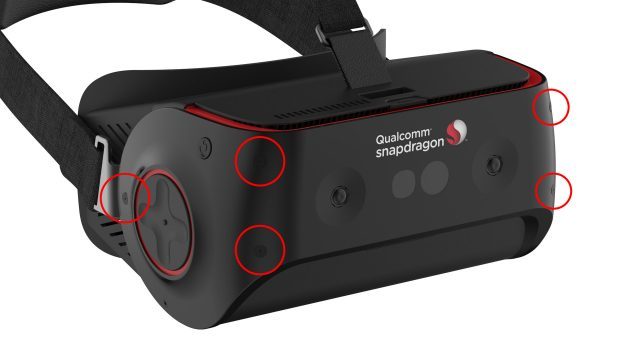Qualcomm’s new Snapdragon 845 VRDK, a VR headset reference design for hardware and software developers, is now offering 6DOF controller input with ultrasonic tracking.
Qualcomm’s Snapdragon 845 VDRK is essentially a starting point for companies who want to build their own standalone VR headsets to offer to customers; the reference headset offers a number of options which can be customized to taste. Options like hand-tracking and eye-tracking have made their way into the offering, and now ultrasonic tracking for 6DOF controller input is available, as noted in a press release by Goertek, the manufurating partner of the Snapdragon 845 VRDK.
Consumer headsets like the Oculus Go, Lenovo Mirage Solo, and HTC Vive Focus are all based on earlier versions of the Snapdragon VRDK, but none of them offer 6DOF controller tracking. 6DOF controller tracking means that the controller can be tracked through 3D space (just like high-end tethered VR headsets), which leads to a significantly more immersive VR experience. The aforementioned headsets only support 3DOF controller tracking, which means only the rotation of the controller is sensed, limiting the feeling of truly having your hands in VR.
6DOF controllers on standalone headsets have been a tough nut to crack because of the difficulties of achieving a large sensing volume without external sensors, and because of the power and compute constraints of mobile hardware compared to PC hardware.
While Oculus has been working on an optical 6DOF controller tracking approach on their Santa Cruz prototype, Qualcomm’s new Snapdragon VRDK hopes to solve the problem with ultrasonic tracking, which uses inaudible sound waves to triangulate the position of an object in space. The latest images of the reference headset show what appear to be six ultrasonic emitters (and/or receivers) on the headset, three on each side. These would be used to either send or receive ultrasonic signals to corresponding controllers, while differences in timing from each of the signals is used to calculate position, which would likely be fused with rotational data from an onboard IMU.

Ultrasonic tracking is not new by any means; we’ve seen VR trackers based on the technology in recent years, and the tech was employed for similar purposes long before the modern era of VR. Pico Neo was one of the first modern standalone headsets we’ve seen using ultrasonic tracking for 6DOF input, though our hands-on with the headset earlier this year didn’t inspire much confidence in the controller tracking.
Generally speaking, the capabilities of ultrasonic tracking have been considered insufficient as a head-tracking solution for high-end VR headsets, though hand-tracking is less sensitive to latency and accuracy, and could prove effective with the right implementation. The Pico Neo solution was developed by Chirp Microsystems, and while the headset is based on an earlier version of the Snapdragon VRDK, it isn’t clear if the latest reference headset is using the same system (we’ve reached out for confirmation from Goertek). The Pico Neo appears to be using three front-facing emitters/receivers on the headset compared to six on the 845 VRDK, which are placed on the front and sides of the device; it remains to be seen what impact this could have on the controller tracking quality.
New standalone headsets based on the Snapdragon 845 VRDK are expected to start popping up in the second half of 2018, though it’ll be up to each company to decide if they want to include ultrasonic 6DOF controller tracking with their headset.







